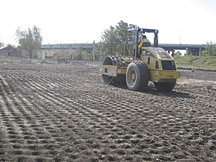Where factories, warehouses, and a junkyard once stood on a 10-acre site on Monmouth Street, 500 new homes may rise in an entire new section of downtown Jersey City.
Once considered one of the state’s most notorious contaminated properties, the site’s cleanup was recently completed, according to the Jersey City Redevelopment Agency.
The city has already enlisted some of the developers who will build residential units as well as 100,000 square feet of retail development.
The city also at one time considered erecting 120,000 square foot municipal office building and a 1,200-car public garage there, but that part is being shelved indefinitely, according to JCRA Executive Director Robert Antonicello. He said City Hall has been forced by budgetary pressure to shrink the size of government.
Instead, the city will seek private developers to build on that parcel.
“A number of people would like to look at downtown as a completed project, and that’s not true.” – Robert Antonicello
________
Mayor Jerramiah Healy said he was happy to see the cleanup done.
“The Redevelopment Agency did an outstanding job in facilitating and coordinating this cleanup,” the mayor said. “Now we can move forward with our redevelopment plan for the area.”
The site is located in a city-designated, specially zoned region called the Grand Jersey Redevelopment Area.
The developers
Eight of the 10 acres that were cleaned up are slated for future development by Roseland Properties and Garden State Development for a project called Harbor Place. Calls to the offices of Roseland and Garden State Development for more information about Harbor Place were not returned before press time.
The remaining two acres were originally intended for the municipal complex.
Turning dirt into gold
Last week, Antonicello spoke about the importance of the cleanup for the city. The role of the Redevelopment Agency, he said, is “taking dirt and making it gold,” which is how he sees the cleanup of New Jersey Turnpike Dump Site, named for its proximity to the Turnpike.
“One of the ways for the city to ease the tax burden is to clean up and remediate land like the Turnpike Dump Site,” Antonicello said. “That creates land that can be developed and built on, and can produce tax revenue for the city.”
Antonicello said the three-year cleanup should be seen by downtown Jersey City residents as an indication that their part of town has not yet been fully developed, despite the general perception. “A number of people would like to look at downtown as a completed project, and that’s not true,” Antonicello said.
When asked why it took so long for the property to be cleaned up when the city has owned the land since the 1960s, Antonicello said it was about the current “market demand” for the area.
“In the 1970s, when the site was used as a junkyard and a dumping ground, there was no real market demand for the property,” Antonicello said. “People talk about location, location, location when it comes to real estate, and it’s really about timing, timing, timing.”
Ricardo Kaulessar can be reached at rkaulessar@hudsonreporter.com.
